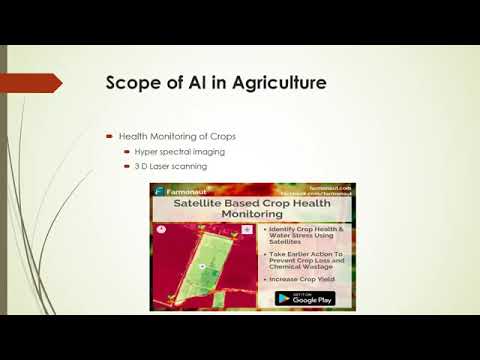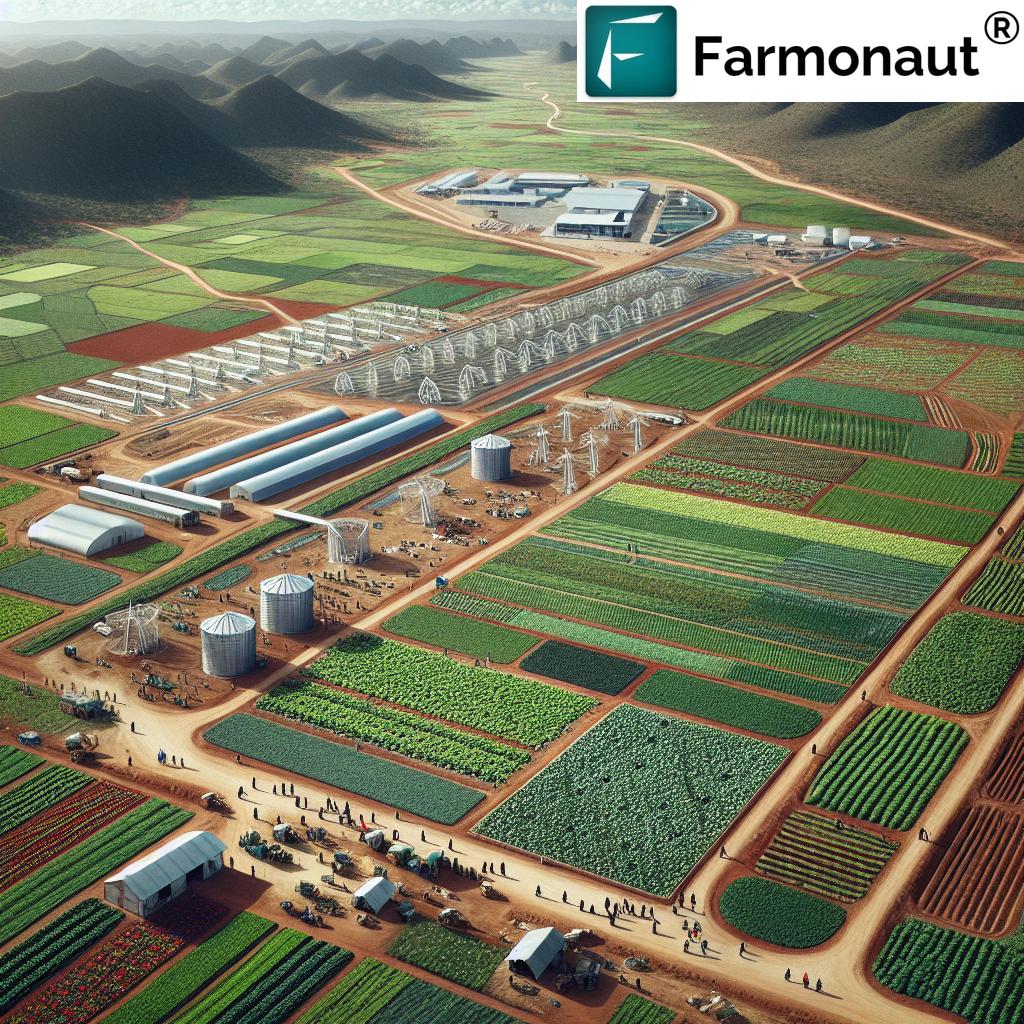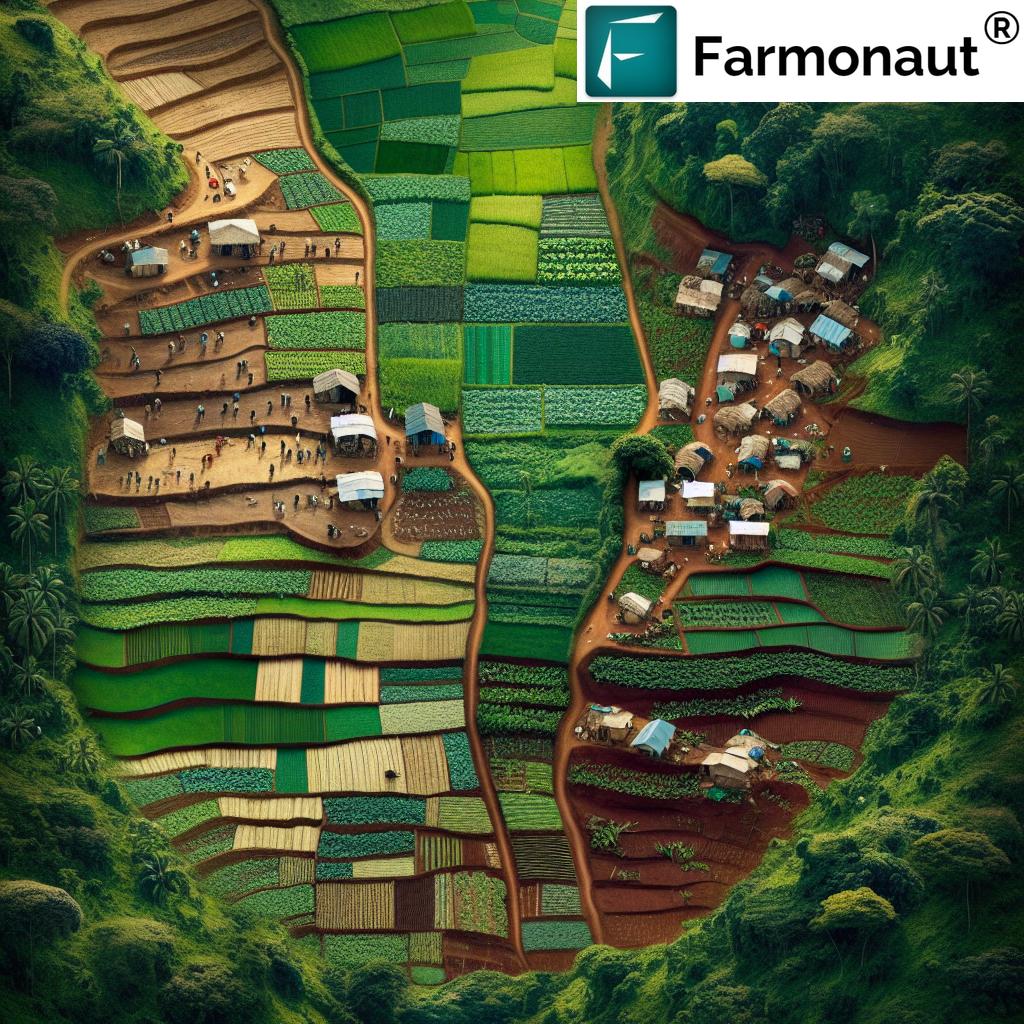Transforming Ethiopia’s Agriculture: Sustainable Agro-Industrial Parks Boost Food Security and Rural Development

“Ethiopia’s integrated agro-industrial parks aim to boost food security for over 100 million people in the country.”
In the heart of East Africa, a remarkable transformation is taking place. Ethiopia, a nation historically challenged by food insecurity and rural poverty, is embarking on an ambitious journey to revolutionize its agricultural sector. We are witnessing the dawn of a new era in Ethiopian agriculture, one that promises to enhance food security, boost productivity, and support smallholder farmers through the implementation of sustainable agro-industrial parks and demand-driven initiatives.
As we delve into this transformative process, we’ll explore how Ethiopia is setting a new standard for African nations and potentially impacting global food security and economic growth. Let’s uncover the strategies, challenges, and innovations driving this agricultural renaissance.
The Rise of Integrated Agro-Industrial Parks
At the core of Ethiopia’s agricultural transformation are the Integrated Agro-Industrial Parks (IAIPs). These parks represent a paradigm shift in how the nation approaches agricultural development and industrialization. But what exactly are these parks, and how do they function?
- Definition: IAIPs are strategically located zones designed to bring together agricultural production, processing, and marketing in one integrated system.
- Purpose: They aim to enhance sustainability and foster collaboration between smallholder farmers and industrial sectors.
- Infrastructure: These parks are equipped with essential facilities including water, power, and storage, creating a conducive environment for agribusiness growth.
The United Nations Industrial Development Organization (UNIDO) has expressed strong support for Ethiopia’s initiatives. Dejene Tezera, the Director of Agribusiness and Infrastructure Development at UNIDO, highlights the shift from a supply-driven to a demand-driven agricultural approach. This transition is crucial as it enables farmers to receive better access to extension services and inputs while providing industries with quality raw materials.
Rural Transformation Centers: Bridging the Gap
A key component of the IAIP strategy is the establishment of Rural Transformation Centers (RTCs). These centers serve as vital links between smallholder farmers and the broader agricultural value chain. Let’s examine their role:
- Support Hub: RTCs provide farmers with access to necessary inputs, technical advice, and facilities for processing and aggregation of their products.
- Value Addition: Through these centers, farmers can add value to their goods before supplying them to industrial markets.
- Knowledge Transfer: RTCs act as conduits for the dissemination of modern farming techniques and market information.
The implementation of RTCs is a game-changer for rural communities. By bringing resources and knowledge closer to farmers, Ethiopia is empowering its agricultural workforce and creating a more efficient, market-oriented system.

Government Commitment and Investment
The Ethiopian government’s dedication to this agricultural transformation is evident in its substantial financial commitment. A remarkable 620 million USD has been allocated to develop the agro-park infrastructure, reflecting a robust commitment to both industrialization and rural development.
This investment is not just about building physical structures; it’s about creating an ecosystem that supports sustainable growth. The government’s strategy encompasses:
- Infrastructure Development: Building roads, power grids, and water systems to support the agro-industrial parks.
- Policy Reforms: Implementing policies that favor agricultural investment and market-oriented production.
- Capacity Building: Training programs for farmers and agribusiness professionals to enhance skills and knowledge.
The government’s efforts are complemented by collaborations with international organizations like UNIDO, creating a synergy that amplifies the impact of these initiatives.
Shifting to a Market-Oriented System
One of the most significant aspects of Ethiopia’s agricultural transformation is the shift from a subsistence-based to a market-oriented system. This transition is crucial for several reasons:
- Increased Productivity: Farmers are incentivized to produce more when they have reliable market access.
- Quality Improvement: Market demands drive improvements in product quality and consistency.
- Income Growth: Access to markets can significantly increase farmers’ incomes, contributing to rural economic development.
The market-oriented approach is strengthening the link between agricultural and industrial sectors, fostering growth and increasing exports. Currently, approximately 170,000 farmers supply raw materials to industries, contributing to exports that totaled around 50 million USD last year. This figure is expected to grow as the agro-industrial parks reach full capacity.
“Ethiopia’s agricultural transformation strategy targets to increase exports by 50% within the next five years.”
Enhancing Food Security and Reducing Waste
A critical objective of Ethiopia’s agricultural transformation is to improve food security. UNIDO’s efforts align with this goal by focusing on tackling food waste and enhancing productivity. Globally, it’s estimated that 30% of food is wasted, an amount sufficient to nourish 100 million people. Ethiopia’s strategy addresses this issue through:
- Improved Storage Facilities: Reducing post-harvest losses through better storage infrastructure.
- Efficient Processing: Developing agro-processing capabilities to extend the shelf life of produce.
- Supply Chain Optimization: Streamlining the journey from farm to consumer to minimize waste.
By focusing on these areas, Ethiopia is not only working towards food self-sufficiency but also positioning itself as a potential food basket for the region.
The Role of Technology in Agricultural Transformation
In this era of digital revolution, technology plays a pivotal role in agricultural transformation. Ethiopia’s strategy incorporates various technological advancements to enhance productivity and efficiency. One such technological solution that could significantly contribute to this transformation is Farmonaut’s satellite-based farm management platform.
Farmonaut’s advanced technology offers real-time crop health monitoring, AI-based advisory systems, and resource management tools. These solutions can provide valuable insights for precision agriculture, helping Ethiopian farmers make informed decisions about irrigation, fertilizer usage, and pest management.
By leveraging such technologies, Ethiopia can:
- Optimize resource use, reducing waste and increasing yields
- Provide data-driven insights to smallholder farmers, enhancing their decision-making capabilities
- Monitor large-scale agricultural projects more effectively
- Improve the overall efficiency of the agricultural sector
The integration of such technologies aligns perfectly with Ethiopia’s vision of a modern, efficient, and sustainable agricultural sector.
Overcoming Barriers to Agricultural Growth
While the potential for transformation is immense, Ethiopia faces several challenges in realizing its agricultural vision. Some of the key barriers include:
- Infrastructure Gaps: Despite significant investments, there’s still a need for improved rural infrastructure.
- Climate Variability: Ethiopia’s agriculture is largely rain-fed, making it vulnerable to climate changes.
- Access to Finance: Many smallholder farmers struggle to access the capital needed for modernization.
- Skill Development: There’s a need for continuous training to adopt new technologies and practices.
Addressing these challenges requires a multi-faceted approach. The government, in collaboration with international partners, is implementing various strategies to overcome these barriers:
- Expanding Irrigation: Investments in irrigation systems to reduce dependence on rainfall.
- Microfinance Initiatives: Providing accessible financial services to smallholder farmers.
- Capacity Building Programs: Continuous training and education for farmers and agricultural professionals.
- Climate-Smart Agriculture: Promoting farming practices that are resilient to climate changes.
The Impact on Rural Development
The agricultural transformation in Ethiopia is not just about increasing crop yields; it’s about holistic rural development. The integrated agro-industrial parks and associated initiatives are catalyzing significant changes in rural areas:
- Job Creation: The parks are generating both on-farm and off-farm employment opportunities.
- Skills Development: Rural populations are gaining access to training and new skills.
- Infrastructure Improvement: The development of parks is driving improvements in rural infrastructure.
- Economic Diversification: Rural economies are becoming more diverse, reducing dependence on primary agriculture.
These changes are contributing to a reduction in rural-urban migration and creating more balanced regional development. The transformation of rural areas is crucial for Ethiopia’s overall economic growth and social stability.
Ethiopia as a Model for African Agricultural Development
Ethiopia’s approach to agricultural transformation is gaining attention across Africa. The success of the integrated agro-parks is positioning Ethiopia as a potential blueprint for industrialization, food security, and economic growth across the continent. Other African nations are looking to Ethiopia to learn from its experiences and potentially replicate its model.
Key aspects that make Ethiopia’s model attractive include:
- The integration of smallholder farmers into the value chain
- The focus on value addition and agro-processing
- The emphasis on sustainable and environmentally friendly practices
- The use of technology to enhance productivity and efficiency
As Ethiopia continues to refine and improve its approach, it has the potential to lead a continent-wide agricultural revolution.
The Role of International Cooperation
Ethiopia’s agricultural transformation is not happening in isolation. International cooperation plays a crucial role in supporting and accelerating this process. Organizations like UNIDO are providing technical expertise, facilitating knowledge transfer, and supporting the implementation of best practices.
Some key areas of international cooperation include:
- Technology Transfer: Bringing in advanced agricultural technologies and practices.
- Capacity Building: Training programs and knowledge exchange initiatives.
- Market Access: Facilitating access to international markets for Ethiopian agricultural products.
- Investment Attraction: Helping to attract foreign investment in Ethiopia’s agricultural sector.
This international support is crucial in helping Ethiopia overcome challenges and accelerate its agricultural transformation.
The Future of Ethiopian Agriculture
As we look to the future, the trajectory of Ethiopian agriculture appears promising. The foundations laid by the current initiatives are setting the stage for sustainable growth and development. Some key areas to watch in the coming years include:
- Expansion of Agro-Industrial Parks: More parks are planned, covering different regions and agricultural products.
- Increased Export Orientation: As productivity and quality improve, Ethiopia aims to become a major agricultural exporter.
- Technology Integration: Greater adoption of precision agriculture, AI, and other advanced technologies.
- Climate Resilience: Continued focus on developing climate-smart agricultural practices.
The success of Ethiopia’s agricultural transformation could have far-reaching implications, not just for the country but for food security and economic development across Africa.
Comparison Table: Ethiopia’s Agricultural Transformation
| Aspect | Before Agro-Industrial Parks | After Agro-Industrial Parks |
|---|---|---|
| Food Security Level | Moderate, with frequent shortages | Improved, with potential for surplus |
| Smallholder Farmer Support | Limited access to resources and markets | Enhanced support through RTCs and market linkages |
| Agricultural Productivity | Low yields, subsistence-focused | Increased yields, market-oriented production |
| Market Orientation | Primarily subsistence farming | Shift towards commercial agriculture |
| Infrastructure Development | Limited rural infrastructure | Significant investment in rural infrastructure |
| Export Potential | Limited agricultural exports | Growing export capacity, targeting 50% increase |
Conclusion: A Sustainable Path Forward
Ethiopia’s journey towards agricultural transformation through sustainable agro-industrial parks is a testament to the power of visionary planning and determined implementation. By focusing on integrated development, market orientation, and smallholder empowerment, Ethiopia is not just changing its agricultural landscape but is also setting a new standard for sustainable development in Africa.
The challenges ahead are significant, but so are the opportunities. As Ethiopia continues to refine and expand its approach, the potential for positive impact on food security, rural development, and economic growth is immense. The success of this initiative could indeed mark a turning point, not just for Ethiopia, but for agricultural development across the African continent.
As we’ve explored in this blog, the transformation of Ethiopia’s agriculture is a complex, multi-faceted process involving government initiatives, international cooperation, technological innovation, and the hard work of millions of farmers. It’s a story of hope, innovation, and perseverance – one that we will continue to watch with great interest in the coming years.
For those interested in staying updated on agricultural innovations and satellite-based farming solutions, we recommend exploring Farmonaut’s suite of agricultural technology tools. Their advanced solutions can provide valuable insights for precision agriculture, helping farmers make informed decisions about crop management.
FAQs
- What are Integrated Agro-Industrial Parks (IAIPs)?
IAIPs are strategically located zones in Ethiopia that bring together agricultural production, processing, and marketing in one integrated system. They aim to enhance sustainability and foster collaboration between smallholder farmers and industrial sectors. - How do Rural Transformation Centers (RTCs) support farmers?
RTCs provide farmers with access to necessary inputs, technical advice, and facilities for processing and aggregation of their products. They act as vital links between smallholder farmers and the broader agricultural value chain. - What is the government’s role in Ethiopia’s agricultural transformation?
The Ethiopian government has committed substantial resources, including a 620 million USD investment in agro-park infrastructure. They are also implementing policy reforms and capacity-building programs to support the transformation. - How is technology contributing to Ethiopia’s agricultural development?
Technologies like satellite-based farm management platforms are providing real-time crop health monitoring, AI-based advisory systems, and resource management tools. These technologies help optimize resource use and improve overall agricultural efficiency. - What are the main challenges in Ethiopia’s agricultural transformation?
Key challenges include infrastructure gaps, climate variability, access to finance for smallholder farmers, and the need for continuous skill development in modern agricultural practices.




















